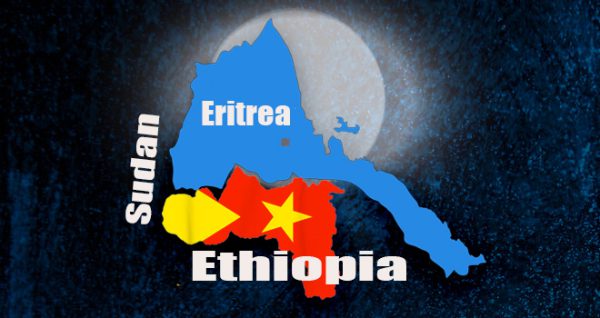Peering into the Cagey Politics of the Horn of Africa

The summit that leaders of Eritrea, Ethiopia, and Somalia held in the Ethiopian cities of Gondar and Bahir Dar in early November is a landmark event in the evolving politics of Africa’s Horn Region. The event’s significance derives not so much from the meeting’s own merits as from the clues it provides on the political thinking of Ethiopia’s Prime Minister Abiy and Eritrea’s President Isaias who have been the prime movers of the notion of “integrating” and “uniting” the countries of the region. To be sure, these enigmatic leaders have leagued together in a grand political mission – bilateral and regional in scope – whose genesis is as mysterious as what it truly intends to achieve.
First and foremost, it was astounding to see the leaders forging a much-publicized alliance almost immediately following PM Abiy’s announcement that his government had accepted the UN-sponsored border ruling. It is all the more so when one considers that: (i) an ugly, two-year war followed by a bitter, eighteen-year-long hostility had kept their two countries at each other’s throat until barely two months before the announcement, and (ii) the resulting peace deal carried no serious commitment by either party to ensuring that the ruinous consequences of the conflict are addressed and the political/economic disputes which led to a war that wrought so much devastation, bloodshed and human suffering are resolved.
Instead, Abiy and Isaias chose to make “regional integration” the overarching theme of their alliance which they formalized by a ‘Joint Declaration of Peace and Friendship’ on July 9 in Asmara, Eritrea. Two months later, they were joined by their Somali counterpart in signing a tripartite ‘Joint Cooperation Agreement’. But here too, they have fallen short: Just a list of the five aspects of the treaty, termed “pillars”, is all that has been made public about the former; no details are known for the latter. In the months since the leaders have provided neither a coherent articulation of the vision they claim to champion nor a roadmap for its realization. Instead, what has been witnessed is a steady stream of empty rhetoric on “integration and unity” accompanied by a fast-paced sequence of diplomatic shuttles, state visits, summit meetings, agreement-signing ceremonies and bestowal of civilian national awards among the players themselves and/or involving their Middle Eastern patrons: the Kingdom of Saudi Arabia (KSA) and the United Arab Emirates (UAE).
The Making of Political Conspiracy
Early last November, Ethiopia’s Amhara Regional State hosted a two-day “political bazaar” that the central government put on display without explaining its true objective(s). The resulting spectacle was a potpourri of political events that included: a peace mission by the country’s prime minister to mediate disputes in the region, an official visit by the president of Eritrea, a “mobile” summit meeting of leaders of three neighboring countries, a showcase of the region’s historical sites and development projects, etc.[1][2] – all rolled into one and having seemingly no particular order of importance to them! The remarkable thing about this misleading hodgepodge of official functions, herein referred to as “Gondar Drama”, is that it happened not by chance, but by design.
The Gondar Drama had its origin in an August announcement that Amhara regional authorities had officially invited Eritrea’s president to visit their region.[3] From the outset, the proposed visit was mired in controversy, raising concerns and arousing suspicions and sensitivities. The president was on record of having already made two state visits to Ethiopia in as many months. Thus, yet another official visit to the same country, so soon and at the invitation of a regional government was something many deemed inconsistent with established diplomatic norms and protocols – not to mention its potential for aggravating the perilous ethnic and political tensions that continue to plague Ethiopia and for complicating still-unresolved issues with Eritrea.
The two-decade-long conflict with Eritrea into which the TPLF-government had plunged Ethiopia ended last July leaving a legacy of bitter animosity between the Eritrean leader and the TPLF. Despite Ethiopia’s recent reversal of its long-held rejectionist stance on the border ruling, the archenemies have yet to dialogue locally on modalities for implementing the ruling – an issue that seems to have hindered border demarcation. Furthermore, Tigray has been entangled in a simmering ethnopolitical tension with the Amhara region over the latter’s grievances against the preceding, Tigray-dominated federal government and contested territories along their shared state-boundary.
It was thus a foregone conclusion that the Tigrai establishment will feel threatened by a visit that smacked of a strategic alliance between Isaias Afewerki and Amhara authorities. Indeed, some observers view the visit and its facilitation by the central government as ‘unholy alliance’ aimed at weakening Tigray and severely restricting its role in the political/military life of the country.
Smokescreen for Isaias’ True Visit-agenda: The government, on its part, was not incognizant of the visit’s potential for stirring up negative public sentiments; and it seemed to go to great lengths to thwart such eventuality by attempting to control public opinion and avert possible political fallout. First, it delayed Isaias Afewerki’s visit for several weeks giving itself time to organize diversionary activities that would conceal the visit’s real objective(s) and to plan ways of controlling and manipulating information about those activities.
A review of local news reports on the subject reveals that, in the days leading up to the staging of the Gondar Drama, the government had largely remained tight-lipped about the affair.[1] The meager information it provided was released in a fragmentary and tardy manner thereby confusing the nature and significance of planned events. Highly revealing of the government’s taciturn disposition in the case was the fact that the Somali leader’s travel to Gondar was decided (and first made public by his own office) just a day before his arrival in Gondar!![4]][5]
Outcome of the “Gondar Drama”? The secrecy that surrounded the launching of the Gondar spectacle was paralleled by government suppression of post-event information about its activities and their outcomes. Even when pieced together, the sketchy reports of the news outlets in the region produced nothing but a collection of semblances and distortions. The government’s attempt at deception is exemplified by the official claim that the leaders “reviewed developments and achievements… [and] …noted with satisfaction the tangible and positive outcomes already registered…” [6] regarding the tripartite agreement they signed less than five weeks prior!
Strangely, no information was released that could provide even the slightest clue of what went on between President Isaias and his hosts, the Amhara authorities, although that event was at the heart of the drama, staged in Gondar and Bahir Dar. Many political analysts now believe that the tripartite summit was nothing more than a government charade played to camouflage an event whose sole agenda was concocting a political intrigue for seizing the upper hand in an ethnic-based conflict that has been brewing up over the last six months.
Observations on Evolving Horn Politics
The political, social, economic and security challenges that confront the Horn region are not only complex in nature but are often exacerbated by the interference of major world powers. Recently, political encroachment by regional powers has added another dimension to this complexity; and the secrecy with which the leaders of Eritrea and Ethiopia are colluding with a Saudi-Emirati intrusion has thrown the future of the region into uncertainty. The void left by the dearth of information on current developments is being filled with assumptions, speculations and outlandish claims to which people are resorting in attempts to explain the present and predict the future. But, more helpful perspectives on these and related issues can emerge if the focus is placed on some key observations.
- No two leaders can be as dissimilar in their essential attributes – education level, age, political experience, philosophy of governance, government system presided over, etc. – as are PM Abiy and President Isaias. But, two critical factors have made them strange bedfellows: (i) The raw ambition that each leader has to become a dominant political figure in Africa’s Horn region and (ii) their willingness to serve as pawns in the regional geopolitical machinations of KSA/UAE in return for infusion of petrodollars which both need to fulfill their respective political ambitions.
- Somalia is already a failed state; Eritrea is a stagnating one. In contrast, Ethiopia possesses huge population, considerable natural resources and steadily-expanding economy, hence is the main target of the KSA-UAE economic agenda in the Horn. Eritrea and Somalia are significant to this agenda only in so far as they provide: (a) maritime access to Ethiopia’s trade and (b) coastal real-estate where Gulf states look to base their troops as they seek to project military power along the globally vital Red Sea-Gulf of Aden shipping lanes.
- The newfound idea of “integrating East Africa” is a project that the KSA-UAE coalition is pushing with the complicity of the two leaders to advance its politico-economic agenda in the Horn. This flies in the face of IGAD, a regional organization comprising eight countries of the Greater Horn and established in 1996 to promote the region’s ‘development and economic integration’. Indeed, PM Abiy’s activism is undermining the mission of an organization whose “rotating” chairmanship has remained firmly in Ethiopian hands for the last 11 years!
The outlook for the Future
It is evident that President Isaias and PM Abiy have embarked on a mission of “integrating and uniting” Eritrea, Ethiopia, and Somalia according to a foreign-devised blueprint. The Somali leader is a reluctant partner whose only motivation seems to be appeasement of Ethiopia’s government – a position likely adopted out of fear of Ethiopia’s aggression and/or in the hope of securing its assistance. On the other hand, the ambitions of the Eritrean and Ethiopian leaders are obviously the products of their contrasting backgrounds, personalities, and philosophies; hence are bound to be vastly different from each other. Thus, the real basis for their alliance may just be the cunning strategy of using each other for advancing their respective selfish agendas – the alliance’s internal contradiction with potential for bringing down one or both of the leaders and/or their mission.
At the national level, socio-political conditions under which the mission has to be accomplished are far from favorable. For starters, the leaders have little popular support for their agenda. As a hard-core tyrant, Isaias Afewerki is a nation unto himself. Somalia’s Abdulahi Mahmud has irked his country’s lawmakers, nearly a third of whom have demanded his resignation for signing a tripartite agreement that they “know nothing about”! PM Abiy is toying obsessively with the idea of making “international boundaries meaningless” in the Horn while his distressed citizens are transfixed by ethnic violence that is ripping their country apart.
The mission’s prospects are not any brighter at the regional level either. Although fellow IGAD member-states had applauded the Ethio-Eritrea peace deal, they seem to have found little sagaciousness in the “unity/integration” craze of the two leaders to offer their comments much less endorsements. More fundamentally, the countries that are ostensibly up for unification/integration are, in fact, facing grave existential threats which have set them on a path to disintegration and extinction, not to integration and amalgamation. Great leaders never allow existential threats to appear on their watch, and make salvation from inherited ones the paramount goal of their leadership. Mediocre and selfish leaders create national threats (as the Eritrean leader has) and/or allow pre-existing threats to fester while they engage in the despicable pursuit of grandeur and vengeance (as the Eritrean and Ethiopian leaders are doing).
Finally, a note on the region’s geopolitics: In 2002 following the Ethio-Eritrea war, America’s diktat brought Ethiopia, Sudan, and Yemen into the so-called Sana’a Forum Cooperation aimed at encircling and isolating Eritrea. Now, nearly two decades later and despite political posturing by Abiy and Isaias, “politics of encirclement” still dominate the region. Eritrea, Ethiopia, and Somalia are working to isolate Djibouti at the behest of the UAE.[5] Likewise, interfering in Ethiopia’s domestic rivalry, Eritrea is conspiring with the federal government and Amhara regional state to encircle and weaken the TPLF. This phenomenon (a combination of shifting geopolitics and entrenched strategy) is reminiscent of Alfonse Karr’s dictum that “the more things change, the more they stay the same”. One can only hope this potentially lethal combination will not throw the region into yet another cycle of conflict.
References




Awate Forum